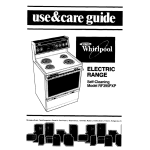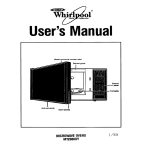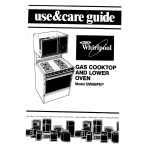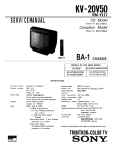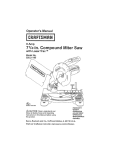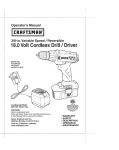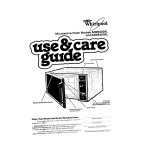Download Maytag 4348340 Installation guide
Transcript
FREE STANDING GAS RANGE USE AND CARE MANUAL Copy Your Model and Serial Numbers IN THE BOX BELOW Model and Serial numbers are on a tag, behind the broiler drawer anel, on the range front frame. Pf you call for service, or with a question, have this information ready. Kee this book, your installation gui 8 e, your warranty and the sales slop together. Model No: Serbal No.. Purchase Dale. Part No. 4348340 (338750) SAFETY RULES. ........................... BURNER IGNIITION. ....................... HOW TO USE YOUR RANGE. ................ ,2-4 .4,5 .5-6 .................... Energy Saving Tips ................ To Use Cooktop Burners. .... To UseTheOven .......................... To Set Clock And Timer. ..................... Oven Light. .............................. Oven Vent ............................. .5 .5 . .6 .6 .6 ............. COOKING HINTS. ............ ................... l Rack and Pan Arrangement. .6-10 .6 l . l l l l l l . l l l l . l Preheating .................................. Using Foil. .............................. Broiling Tips. ......................... Broiler Pan. ..................... Positionin : : .8 .6 ....... CLEANING AND CARE. ..................... l Oven Cleaning, ........................... Instructions. ......... Cleanin l Remova ?I le Cooktop Burners ........ l Removable Roll-Out Broiler. ................ . Removable Oven Racks. ................... l Removable Oven Bottom. ................... l Removable Oven Door. ..................... . Loft Up/Off Cooktop. ....................... l If you smell gas: 1. Open windows 2. Don’t touch electrical switches. 3. Extinguish any open flame. 4. Call your gas supplier immediately. :: .7 Roasting 8. Ips .............................. ................. Using a Meat Thermometer. Adjusting Oven Temp Knob, ................. Choosrng Cookware, ....................... Common Baking Problems and Causes. FOR YOUR SAFETY .... ......... .8 ,9 .9 10 lo-14 10,ll 11,12 12 13 .13 .13’ .14 .14 15 PREVENTING SERVICE CALLS. ................ FIND PROBLEMS DURING THE WARRANTY PERIOD Warranties Are Based On Time, Not Usage. You should try each feature and control on your new range soon after 1 installation. FOR YOUR SAFETY Do not store or use gasoline or other flammable vapors and liquids in the vicinity of this or any other appliance. L.P. Burner Adjustments The adjustments in your Installation Guide must be made before you try to use your range. If you are using Liquified Petroleum Gas (bottled gas) all L.P. adjustments in your installation guide must be made before use. If your range is not properly adjusted, flames may be too high, or the range may use too much fuel, release toxic fumes or cook poorly. Model and Serial Numbers Put the Model and Serial Numbers of your new range in the box on the front of this book. Find these numbers on a metal plate under the lift-up cooktop. IMPORTANT INSTRUCTIONS ONLY YOU CAN PREVENT ACCIDENTS! Read the Safety Rules below and all operating instructions before using this appliance. GENERAL Keep this book for later use. Be sure your range is put in and grounded by a skilled technician. Never tr to fix or replace any part of the range unless the book tel rs you to. All other work should be done by a skilled technician. Never block free air flow thru the oven vent (see page 6) or to the cooklop burners. Onl some kinds of glass and ceramic pans can be used for coo 1:top cooking. Be sure that the pan ou use will not break when heated on the cooklop burner. !zee page 9 for tips on cookware. Never leave the oven door open when you are not watching the range. Caution - Do nol store things children might want above a range. Never let children climb on any part of Ihe range NO! CHILD SAFETY Teach your children part of the range. not lo play with range knobs or any other SAFETY Never use your range to heat dangerous and hurt range parts. a room. Doing so can be NO! Never leave children alone or unwatched where a range is in use. Never let children sit or stand on the cooktop or open oven door. The child’s weight may make the range tip over -c Never wear loose or hanging clothes Such clothes could catch fire. whtle using your range. GREASE FIRES Never leave cooktop burners unwatched at high heat selltngs Boilovers cause smoktng and greasy splllovers may catch fire NO! NO! Never heat unopened food containers. Pressure build-up may make container burst and cause injury. Never let pot handles stick out over the front of the range. Turn handles In, over the cooktop, so that they cannot be bumped into. Be sure not to turn handles over another burner. They may get hot and burn you. Always keep the range area clear and free from things thar could catch ftre, gasoline and other flammable vapors and IIuids. Never store things in an oven or near cooktop burners ? hese things may catch fire and plastic items may melt and burn. NO! Always use care when opening steam out before moving food. the oven door. Let hot air or Always move oven racks while oven is cool Always use dry potholders when removing pans from the oven or cooktop. Moist or damp potholders can cause steam burns. Do not use a towel or other bulky cloth. NO! Never use aluminum foil to line drip bowls (under burner grate) or oven bottoms. Only use foil as shown on page 7 of this book. Improper use of foil can start a fire or keep all the gas from burning. Never leave Jars or cans of fat or drlppings on or near the range. Never let grease build up on your range. You ca,n keep grease fire from starting if you clean up grease and sptllovers after each range use. NO! then lift up the cooktop. The cooktop pilofs are located between the front and rear burner on each side of the cooktop (see illustration). 3. Light pilot(s) with a match. PUTTING OUT A GREASE FIRE A dry chemtcal, foam or t-talon type fire extinguisher should be near the range where you can easily reach iI in case of a cookin fire. A Halon extinguisher will not spoil the food and ma1 es no mess. Never use water on a grease fire - it will only spread the flames. Never pick up a flaming pan. Instead: 1. Turn off the burner 2. Smother the fire with a tightly fitting pan lid, baking soda or an exttnguisher. To Light Gas Oven Pilot: 1. Turn the OVEN CONTROL knob lo OFF and wait one minule before lighting pilot. 2. Open the broiler, lift up on the handle sltghtly, and pull the broiler door down flat. Put the brorler pan In the lowest posltlon and slide the drawer back into the range so you can reach Inside the broiler easier. 3. Find the oven pilot at the back of the brotler compartment The Ion tube at the top of the compartment, running from fron! lo bat 1. , IS the oven burner. The pilot is at the back, about 1 Inch below the burner. See tllustralion below 4. Light the pilot wtth a match How lo put out a liquid grease fire with a fire extinguisher: 1. Stand back 5 or 6 feet. 2. Open the extinguisher. 3. Starting at the flames closest to you, move the extinguisher side to side and work back until all flames are out. CAUTION: If you brin the extinguisher too close you may blow burning grease aBI over the cooking area. FOR RANGES WITH STANDING PILOTS To Light Gas Cooktop Pilots: 1. Turn the burner controls to OFF and wait one minute before lighting pilots. 2. Remove the burner grates and drip bowl liners (some models), 4 I FOR RANGES WITH SPARK To Manually Light Cooktop Spark Ignition lGNlTlON Burners With Set controls so flame heats pan bottom only and does not lick pan sides. Flames licking pan sides CAUTION Gas Pilot Models Lighting gas burners with a match is dangerous. The flames can burn ou or a buildup of gas can explode. You shoul 4’ match light the cookto burners only in an emergency. NEVER mate 6 light spark ignition oven burners. When you turn a control knob on, the burner is lit by a constantly burning pilot To light a burner: 1 Push the control knob In and turn It left to LITE. 2 When the burner hghts, turn the knob to set flame size. Spark During a power failure the burners WIII not ltght aulomalrcally. In an emergent , acooktop burner may be III wllh a malch by followIng the steps r; elow 1 Light a match and hold Ihe match flame near the burner you want to light Wooden matches work the best. 2 Push in and turn the control knob slowly. Be sure you are turntng the knob for the burner you are lrghting Note: If burner does not Ii ht within five seconds, turn the knob off and wait one minute be ?ore trying again. Do Not Ignition Manually TO USE COOKTOP Light Oven Burners With IF A BURNER Spark Models DOES NOT LIGHT If a burner fails to light wilhrn five seconds, lurn the knob lo OFF and wait one minule before trying again If the burner still WIII not light, check Prevenhng Service Calls on page 15. BURNERS A sign near each cooktop conlrol knob shows which burner IS turned on by that knob. For example, when you turn the knob nearest to : :, the rrghl front burner WIII lrght You should always light the burners before putting a pan on the burner grate. ENERGY l l Some models have a cone-shaped cooktop burner, with a circular openmg through the center of the burner, at the right front cooktop posltlon This “All-Purpose Burner” can provide one third agafn as much heat as the other three. Use the “All-Purpose Burner” for ccoking large amounts of food in a big pan, canning, etc. See addttlonal information on page 12 Ignition When you turn a control knob to LITE, the burner is lit by a series of electric sparks (ticking sound) from the igniter. To light a burner: 1. Push the control knob in and turn it left lo LITE. 2. When the burner lights, turn the knob to set flame size. IMPORTANT:Do not leave the control knob on LITE after Ihe burner is lit, or the life of the spark igniter may be shortened. l l l 5 SAVING TIPS Be sure the burners (and pilots, tf applicable) are properly adlusted when your range is installed. Adjustment information is in your Installation Guide Clean all burners often (see pages 11 and 12) Dirty burners reduce efficiency ‘When Possible, thaw frozen foods before cooking, cook with the minimum amount of waler and use a pan with a lightly fitting lid. Adlust the flame to fit the size of the pan Be sure lo watch foods when healing them quickly on HI. As soon as the food reaches the cooking lemperalure, turn down the heal IO the lowest setting that ~111keep it cooking. TO USE THE OVEN OVEN VENT Baking and Broiling 1. Set OVEN CONTROL knob to BROIL or needed temperature. 2. When hnished turn knob lo OFF. When the oven is on, heated dtr moves through a vent in or below the backguard On the cooktop, thus hot atr may make pot handles hol or melt plastic lhmgs left too near the vent The vent IS needed for proper air flow In the oven and good baking results. Do not block thts vent. Doing so may cause cooklng fatlure. fire or damage to the range TO SET THE CLOCK (Some Models) 1 Turn the clock/timer knob in the counterclockwise direclion untti the words “SET TIME” are displayed. 2 Tern the Clock/Timer knob in either direclion lo set the lime of MOISTURE As your oven heats up, water droplets may form on the door or door glass. To prevent this, open the oven door for the first minute of oven heat up 10 let the moist air out. RACK AND PAN ARRANGEMENT Put oven rack(s) in place before turning on the oven. Rack POSIlions are numbered 1 to 4, starting at the bottom with number 1. In general, when ustn only one rack, positron No. 2 should be used When using two rat t s, positions No. 2 and 4 work best. When using cookie sheets place them with the long side of the cookie sheet toward the from of the oven and centered on the rack. When using two cookie sheets at the same time use rack positions No. 2 and 4. The cookies on the lower rack may be done l-2 minutes before the ones on the higher rack. You may want to switch rack positions when baking is halfway finished. Pans too close to each olher. to oven walls, or to the oven bottom block the free movement of air. Improper air movement causes uneven browning and cooking SET TO SET THE TIMER (Some Models) 1 Turn the Clock/Timer knob in the clockwise direction until words ‘SET TIMER” are displayed. 2 Turn the Clock/Timer knob in any direction lo set amount time. The timer WIII automatically start counting down. 3 When lime is up, 3 beeps will sound. NOTE: To cancel timer, turn Ihe Clock/Timer knob until display reads :OO. While the limer is being used, the time of day will be shown in display about every 10 seconds. NEW OVEN the of the lhe ODOR During the ftrst bakm and broiling cycles in your new oven, there may be scme odor T8.IS IS normal and is caused by the heating of new parts and insulation. The odor will go away withm a short lime A vent fan or other ventilation will help to clear the air. OVEN LIGHT (Some The pan or pans ustng the least rack area should be placed on Ihe lower of Ihe Iwo racks Models) Some models have an inlerior oven light. To turn the oven light on and (ofI. push the Oven Light switch on the control panel Should you ever need a new bulb, use a 40 watt appliance bulb. 6 PREHEATING Preheating lets the oven heat evenly before the food IS put tn. Allow 10 minutes at temperatures less than 350°F and 15 mtnutes at 350” F or more. With recipes that call for an oven preheated lo a certain temperature, it is ver important that you follow those inslructrons It is not likely t i at you will get ood baking results every time without preheating to the neede 3 temperature, unless the recipe says to start in a cold oven. After the oven is preheated and you are ready to put the food in, try to have everylhtng handy so that you will not have lo leave the oven door open for an extended period of lime Opening the door often to check the food durrng baking makes tt rmposstble for the oven to stay at the temperature you have selected. Try to time your baking and check only when close to being ftnished. NOTE: When using cookware made of ovenproof glass or pottery, ans In the oven, Teflon@ coated cookware and dull or darkened be sure to reduce recipe temperature by 25 4 (see Chooslng Cookware, page 9). USING FOIL For Baking TO catch sprllovers. cul a piece of foil sltghtly larger than the pan and turn up the edges Use two oven racks and put the foil on the lower oven rack below the pan Do not use aluminum fotl directly under a pan on the same oven rack The loll wrtl reflect heat away from the pan. CAUTION Do not cover the oven bottom or an entire oven rack with foil. The foil can block normal heat flow, cause cooking failures, and damage the oven interior. For slow browmng. place a fotl “tent” loosely over the meat Thus IS especratly good on a large turkey Do not seal the forI Sealrng the fool wrll tend to steam the meal To reduce spattering, lightly crush foil and put it in the bottom of the pan under the food. For Broiling CAUTION Do not cover the broiler grid with foil. Hot fat on the fotl may cause a broiler fire. If a fire starts. close the oven door and turn controls off. If fire does not go out, throw baking soda on the fire. Do not put water on the fire. BROILING TIPS Your oven and broiler doors should be completely closed while broiling. Use only the broiler pan and grid that came with our range for They are made for proper drarnage of 7at and lrqutds brottin and he 9p prevent spatter, smoke or fire. Do not preheat when broiling For even brorltng on both sides, start the food on a cold pan Allow sltghlly more than half the cooking time for the first stde then turn the food usrng tongs If you prerce the meat with a fork, the futces WIII escape When broiling frozen meat. use one rack postron iower than shown In the chart and up to 1’12times the brorlrng trme Tram the outer layer of fat from steaks and chops Slrt Ihe fatty edges tc keep the meat from curlrng Always put the food berng brorled on !he proper rack (see chart at rrght) Food placed too close to the broiler may spatter smoke or catch fire For maximum jurcrness. salt the first srde lust before turning the meat. Salt the second srde lust before servrng Brush chrcken and fish wrth butter several ttmes as they brorl When brorlrng fish. grease the grid lop revenl stickrng Never leave a sorled brorler pan in the range Grease rn the pan maysmokeorburnthenextttmetheovenrsused Seepage11 for tips on cleanrng the brotler pan and grad Be sure you know how to put out a grease fire See page 4 POSlTlONlNG ROASTiNG BROILER PAN Hack Position I 3 =Highest I Food 1 f TIPS Roastrng trme WIII depend on the oven lempera!ure meal temperature, srze, shape and type of the meat Ihe properllon ol bone and fat. and the degree of doneness (Internal lemperalurrj you desire l Add extra time (15 to 25 mnules per poundjti’hen roas!lng frozen meats l For even cooking, put the meat In the pan wrlh the lal srde up l Use a roasting pan that fits the size of the roast Too smal! a par) WIII let the melted fat drop over the edge and loo large a pan ,VJII~ cause spattering l Reduce spatlenng by putlrng lrghtly crushed (011 I” the pan under the food. l To best measure doneness, always use a meat thermometer l For easier carvrng, let Ihe roast stand 10 to 2G rnlnrlteS alter removing II from the oven Always carve across the gram c( mea: rasp the handle and pull the To open the broiler compartment, door toward you After placing foo I? on the broiler pan, slide the pan into the proper rack position Be sure the sump (grease well) In the pan is to the front of the range. See the chart below for recommended rack posrtion and cookrng time. The closer the food IS to the broiler burner the faster the meat browns on the outside, yet stays red to pink in the center. Moving the meat farther away from the burner lets the meat cook to the center while browning outside. Total Time I (Minutes) I ~ USING A MEAT THERMOMETER This chart IS a general urde. The srze, werght, thickness trng temperature of t9, e food, as well as your own preference, will affect cookrng time and starpersonal 8 Strck the thermometer Into the center of the iar est muscle c1t meat, or In the Inner thlgh, or breast of poultry Por an accurate readrng. the tip of the thermometer should not touch bone or grtstie or rest In a pocket of fat As the meat cooks. the thermometer may slop from IIS posItIon II the readrng on the thermomefer seems unusually hrgh for Ihe length of lime the meat has cooked, check the thermometer and reposrtron it If necessary If you let a roast stand 10 to 20 mrnules alter you remove II lrom Ine oven, It WIII be easier to carve and the Internal temperature +JI~I rarse as It stands Remove the roast from the oven when the Ihermometer reads 5°F to 10°F less lhan the Internal temperature fou destre If you do not plan to let the roasl stand, leave the meal IP the oven until the full temperature IS reached ADJUSTING OVEN CONTROL KNOB CHOOSING The temperature in your new oven has been set at the lactory, so be sure to follow the recipe temperatures and times the first few limes you bake in your new oven. If you think the oven should be hotter or cooler, you can adjust it yourself. To find out how much to change the temperature, set the oven control knob 25°F higher or lower than the temperature in your recipe, then bake. This “test” should give you an idea of how much the temperature should be changed. To rd)urt knob: 1. Turn OVEN CONTROL knob lo OFF and remove the knob by pulling straight off. 2. Look at the back of the knob. The arrow pointing to the center of the upper screw shows the original factory setting. The knob can be set for up to 75°F hotter or 75°F cooler, in 15°F increments. 3. Use a screwdriver to loosen the two screws about 1 turn each. 4. Hold the knob handle (A on illustration) while turning the knob skirt (B on illustration) to Hotter or Cooler. As you turn, you should be able to hear clicks and feel notches or teeth. Each click or notch is 15°F. You can turn up to 5 clicks or notches in either direction. 5. Retighten both screws. COOKWARE COOKTOP COOKWARE ALUMINUM: Sp oads heal qurckly and evenly Best for frying, braising and pot roasts. CAST IRON: Slow to change temperature and holds heat. Good for browning, frying and stewrng. COPPER (Tln-Lined): Quick to change temperature. Great for gourmet cooking, wine sauces and eg ~,corC$e$ye,‘i~~nenygoi,wll: wear thin with use. Cookware must poisonous reaction between the copper, the heat and the food. GLASS CERAMIC: Slow to change temperature. Best for tong, low heat cooking with a liquid. PORCELAIN ENAMEL: Porcelain enamel over steel IS long lasting, stain and scratch resistant. How well it heats depends upon the type of steel used. Best for cooking soups and other liquids. STAINLESS STEEL: Usually combined with other metals such as aluminum. copper or carbon steel. These other metals make the cookware heat more quickly while the stainless steel makes it strong and long lasting. Best for frying, sauces, soups, vegetables and egg cooking. OVEN COOKWARE ALUMINUM: Absorbs heat faster than glass or steel and conducts heat well. Gives delicate browning, tender crusts, and reduces spattering of roasts. Best for cakes, muffins, quick breads, cookies and roasting. OVENPROOF GLASS/POTTERY: Because this cookware absorbs and holds heat well, you should should lower your oven temperature 25” F. Gives food a deep, crusty brown top. Best for casseroles. TEFLON@, DULL OR DARKENED COOKWARE: Absorbs heal quicker than shiny cookware. Lower your oven temperature 25 F’ (sehxFsptfor pastry). Good for pies and other foods baked in pastry 9 0. Can I use special cookware, like an oriental wok, on my cooktop burners. A. Some oriental woks have support rings that block free air flow that is needed for proper operation of burner. Also, the trapping of high heat around burner may dama e cooktop. You should not use utensils which go below the top oB the cooktop burner grate COMMON CAKE RISES UNEVENLY Ran e or oven rack not leve B l l l Pan warped l Batter spread unevenly pan l in l l Pans iO0 close to oven wall or rack to crowded l OVEN CLEANING BAKING PROBLEMS AND CAUSES Some models have a standard porcelain oven hnrsh and some models have a continuous clean finish on the oven top, back and srdewalls. Standard porcelam IS smooth. The continuous clean finish has a rougher texture. BOTTOM PIE CRUST SOGGY Filling too juicy Filling allowed to stand in pie shell before baking Used shiny pans Temperaturetoolowatstart of baking See the cleaning instructions on page 12 to find out how to best clean the standard porcelain frnrsh If your oven has the continuous clean finish, read below how thus specral porcelain enamel works and how to care for II. On a smooth standard porcelarn surface, a fat spattei beads up. then chars and turns black. On the rougher continuous-cleanrng surface, a fat spatter spreads out forming a larger area and then gradually burns away at medium to high bakrng temperatures CAKE HIGH IN MIDDLE l TOG much flour l Oven temperature too high CAKE NOT DONE IN CENTER l Wrong pan srze l Oven too hot l Par not centered in oven CAKE FALLS l Too much shortening. quid or sugar l Temperature l Pan loo small l l l li- too low Oven door opened too often Too much leavenrng stale leavening Overrmxrng flour or after adding BURNING AROUND EDGES OF PIE CRUST l Oven temperature too high l Edges of crust too thin or too high l Oven too full or pans too close together COOKIES AND BISCUITS BURN ON BOTTOM l Oven preheat time too short l Pan too deep or too large l Used dark pans l Used wrong rack position FOOD NOT DONE AT END OF COOKING TIME 9 Oven temperature set too IOW l Oven too crowded l Oven door opened too, often l Alumrium lo11blockrng arr movement You do not have lo wipe up heavy spatters. but it may speed the cleaning action. If you wish to wipe up heavy spatlers. follow the trps below so you do not damage the contrnuous-cleanrng frnrsh l l Use clear water or deter ents such as Fantastlk. Lrquld Ajax. Top Job, Liouid Lysol or%r, Clean, mixed In waler. and a so’: cloth or nylon brush to clean any heavy spatters Do not use paper towels or sponges because will rub off and clog the pores of the fmrsh !hese malertals - After cleaning the surface, rrnse It well. usrng three tablespoons of vrnegar, mixed with a quart of cold water Blot up excess liquid. 9 Never scrape or use abrasrve materrais such as scou’lng powders. commercial oven cleaners or steel scourrng pads for cleaning up heavy spatters These materrals wil scratch and damage the frnrsh The higher the oven temperature. the faster the cleaning actjon The lenglh of cleaning hme WIII depend on the type and amount of sorl. oven temperature and the length of time the oven IS used So11 will slowly go away with normal oven use Cleanrng occu:s whenever the oven IS turned on for bakrng or roasting The oven will look presentably clean, even thou h some spatters may be present. No cleanrng takes place when Ia e oven IS off 10 Conlmuedon nextqge CLEANtNG INSTRUCTlONS A heavy spatter has filled the pores and formed a mound of soil. The heavy s atter has been wiped up. P he continuouscleaning action will begin the next time the oven is used. This shows the amount of soil remaining after a few hours of oven use. The soiled area is smaller and lighter in color. After more oven use, the soil has been removed. NOTE: If any stubborn stains remain after normal oven use, you may run the oven empty at 400°F for additional continuouscleaningaction. Some foods may leave a light discoloration even when the surfaceisclean. You can protect the oven bottom from heavy spillovers and cut your ,cleaning,time by usin! a piece of aluminum foil under your cookmg utensrl. See page 7 or bps on using foil correctly. CONTROL PANEL AND KNOBS: Pull knobs off and wash at sink tn soap and water Wash control panel wrth soap and water, rinse with vinegar and water and dry with a paper towel. COOKTOP BURNERS: Wash with soap and water and a non-metal scouring pad. To clean stubborn soil, remove burners (see instructions on pa e 12). FIII a non-alummum pan with water to cover the burner a ead Boil water, then slowly add 2 tbsp. of dry Dip-it granules per quart. Add burner with head down and boil for 20 minutes. Remove burner and rinse. Wipe an remainmg soil off wtth a cloth or soft brush. Drain out water an d heat burners in a warm oven (200’ F) for about ‘12 hour to dry completely. After cleaning or a spillover, Ii ht the burners and make sure no ports are clogged (see page 18 ). Do not use all-purpose cleaners, ammonia, powder cleansers or commercial oven cleaners. They can scratch or discolor aluminum. BURNER BOX (Under Cooktop): Raise or remove cooktop as shown on page 14. Wash with soap and water, lhen dry. OUTSIDE FINISHES CHROME (Some Ceokto ): Wash with soap and water. For heavy soil, cover with a damp c P0th and lel soak for 30 minutes. A chrome cleaner may be used. To remove fin erprints on brushed chrome, apply a little bab oil or cookin \ oiawith a cloth or paper towel. Rub in the same J rrechon as the rush marks on the chrome. GLASS (Clock Cover, Some Oven Doors): Wash with a soapy cloth, well wrung out. Remove stubborn soil with a paste of baking soda or ammonia and water. Do not use abrasive matertals. Before using an all-purpose cleaner, check the label to be sure it is recommended for glass-some wrll permanently damage glass. To hel prevent a brown film from forming on the window the next time t t e oven is heated, rinse the insrde of the window with vinegar and water, then dry with a paper towel. PAINT (Range Sides, Broiler Door Backguard): Wash with soap and water then rinse with vinegar and water and dry with a paper towel. Avoid cleaning powders or abrasives which may scratch thesurface. PORCELAIN (Some Cooktops : Porcelain enamel can crack or chip with mtsuse. It can stain I.I actd s; rllovers are not cleaned up uickly. Wash with soap and water. or heavy soil, cover with a 3 amp cloth and let soak 30 minutes or use a scourin pad. Rinse with vinegar and water and dry with a paper towel. IByou are not 11 sure if a surface is paint or porcelain, follow the instructions in the To remove burners: 1, Gras the burner head and tilt it to the right to release the two tabs Prom the burner support (A in Fig. A). 2. Lift the end of the burner assembly, then ull away lrom the front of the ran e to free the air shutter Prom the gas valve orifice (B in Fig. 1 ). Check lighter and burner ports (Fig. B). If they are clogged, use a wire or needle to clear them. See the Cleaning Instructions on pages 11 and 12. Be careful not to disturb the air shutter setting while cleaning. If you need lo readjust the air shutter, see you Installation Guide. paint section on page 11, VINYL (Some Oven Handles): Wash with soap and water then dry. Do not use abrasive or caustic cleaners. OVEN FINISHES STANDARD PORCELAIN: Soak stubborn stains with an ammonia soaked paper towel or set a dish of ammonia water in oven over night to loosen soil! then scour. Rinse with a mixture of vinegar and water. When using oven cleaners, follow package directions. For smooth standard porcelain areas of continuous cleaning ovens you can use a non-aerosol oven cleaner. Be sure that no oven cleaner touches tne rougher continuous cleaning finish. You can remove the oven bottom for cleaning (see pa e 13). Be sure that no trace of the oven cleaner sta s in the oven. a races of oven cleaner could put stains on the finis i when heated. To make sure this does not happen give a final rinse of vinegar and water. CAUT!ON: Do not coat thermostat bulb (wire in upper part of oven) with oven cleaner. Never use oven cleaners on outside range surfaces, aluminum, chrome or baked enamel. CONTINUOUS CLEANING: Follow special instructions for continuous cleaning ovens on pages 10 and 11. Never use any oven cfeaners or abrasive cleaners. OWEN RACKS: Remove from oven (see InstructIons on page 13) and wash at sink with soap, water and a scouring pad. BROILER PAN AND GRID: Do not leave in range to cool. If you clean right away, the soil will steam loose while you are eatrn Remove pan from broiler and remove fat and drippings. Sprink Be an with detergent then cover with a wet cloth or paper towel and Pet soak. Later wash in soa and water using a scouring pad as necessary. Both the pan an 8 the grid are dishwasher safe. BROILER COMPARTMENT: Wash with soap and water. For heav %I, use a scouring ad or a brush on oven cleaner. Rinse wtl4 vinegar and water an s dry with a paper towel. REMOVABLE COOKTOP Some models have an “All-Purpose Burner”. Be sure that lhe coneshaped “All-Purpose Burner” is returned to the right front cooktop posItIon. Damage to your range may result if smaller burners are used In tt.ls position To replace burners: 1. Slip the air shutter over the gas valve orifice (Fig. A). 2. Lower the burner assembly and hook the tab in the slots in the burner support(Fig. A). 3. Be sure both tabs are in their slots, that the burner sits level and straight and that the flash tube forms a straight line from the pilot or igniter to the burner (Fig. B). Fig. A BURNERS The cooktop burners on your range may be removed for cleaning. Be sure all cooktop knobs are turned to OFF and burners are cool, then remove or raise the cooktop. II shipping screws were not removed from the burners when the range was installed, do so now (see your Installation Guide for instructions). These screws may be discarded. Fig. 12 B REMOVABLE ROLL-OUT BROILER REMOVABLE To remove the roll-out broiler for easier cleaning: 1 Pull brorler out until rt stops. 2. Grasp handle, IIH front of broiler and pull brorler out See the Cleanrng lnstructrons To replace broiler: on pages 11 and 12. 1 Put the slrde blocks under the brorler behind the broiler stops In the range. 2 Hold broiler In the rarsed positron as you slrde it pan way Into the range, then lower broiler and push completely closed SLIDE BLOCK OVEN BOTTOM The oven bottom in your range can be removed for easier cleaning. If your oven has a contlnuouscleanlng oven finish, be careful not to scratch the finish when removing or replaclng the oven bottom. To remove: 1. Grasp at finger slots in each side of Ihe oven bottom. 2. Lift the front edge of the oven bottom enough to raise the tabs from the slots in the front frame. Push the oven bottom back about 114" to release the flange from lhe front frame, then pull out. See the Cleaning Instructions on pages 11 and 12. To replace: 1. Slide the oven bottom into the oven so the back tabs fit into the slots in the oven back. 2. Grasp at fin er slots and push the oven bottom back and then down to hoo a the flange under the front frame. 3. Fit the front tabs into the slots in the front frame. STOP REMOVABLE OVEN RACKS If you oven has a contlnuouscleanlng to scratch the finish when installlng To install: 1. Set the raised back edge of the guides. 2.Push the rack in until you reach ;;en lift the front of the rack a bit oven finish, be crrrful or removing oven racks. rack between not a pair of rack the bump in the rack guide, and push the rack all the way -T--==% See the Cleaning instructions on pages 11 and 12. To remove: Pull the rack out, then up FLANGE REMOVABLE OVEN DOOR LIFT UP/OFF COOKTOP To remove: 1 .Open the door to the stop position (see the illustration). 2. Grasp the door at each side and lift up and off the hinges. See the Cleaning Instructions on pages 11 and 12. NOTE: When the door is removed and hinge arms are at stop position, do not bump or try to move the hinge arms. The hinges could snap back causing an injury to the hands or damage to the orcelain on the front of the range. You may wish to cover the c.urges with toweling or empty towel rolls while working in the oven area. To replace: 1. Hold the door over the hin es with the slots at the bottom ed e of the door lined u with t e hinges. The hlnge arms must s 8Ill be In the stop posh Pon. E 2. F;z,“;;; door down onto the hinges as far as it will go and close The cooktop can be raised or removed so the area under it can be cleaned. To raise cooktop: 1 Remove the burner grates. 2. Grasp the front of the cooktop and IIH up. For ranges with a support raise the cooktop untrl support rods snap into positron. To remove cooktop: 1. Remove the burner grates. 2. Grasp the cooktop and IIH the front a little. 3. Grasprng the cooktop at the sides, hold it nearly flat while you IiH up and off. For ranges with a support unhook the bottoms of the supports from the range sides. To keep from chipping or damaging the porcelain finish, be careful not to drop the cooktop. See the Cleaning Instructions on pages 11 and 12. When finished cleaning carefully lower the cooktop into place. HOLD COOKTOP HINGE STOP POSITION 14 FLAT TO REMOVE IF YOU HAVE A PROBLEM OVEN/BROILER BURNER DOES NOT WORK l Check to be sure the range cord is plugged into the household outlet completely (spark ignition models only). Check for blown fuse or tripped crrcuit breaker. l Range not properly grounded or polarized. This can affect ignition on spark ignition models. See your Installation Guide. l Pilot light out (pilol models only). See page 4 to relight pilot. l Check for power outage. l Is the Oven Control knob turned on? l Burners not adjusled properly. See your Installation Guide for adfustment information. Problems are often caused by little thin s that you can fix yourself without any tools. Make sure you are fo9 lowrng rnstructions in this book and read the list of common problems and solutions on this page If you have a problem you can not fix yourself, call your authorized dealer for help. CLOCK/TIMER DOES NOT WORK l Check to be sure range cord is plugged into outlet completely. Check for a blown fuse or tripped circurt breaker. 9 Check for power outage l Check step by step operating instructions on page 6. OVEN LIGHT WILL NOT WORK l Check for a blown fuse or tripped circuit breaker. l Bulb loose or burned out. Use a 40 Watt appliance replace l Power outage-check by trying household lights. OVEN TEMPERATURE SEEMS INACCURATE l Check lo be sure the thermostat sensing bulb (wire in upper part of oven) is in clips, straight, and not touching oven sides. l Is proper airflow blocked by aluminum foil? See page 7 for tips on correct use of foil. l Is the oven vent blocked? See page 6. l Check the section on baking problems and causes on page 10. l The oven thermostat on our new range may be more accurate than the one on your 01J range. See page 9 for information tin adjusting the Oven Control knob. bulb lo COOKTOP BURNER DOES NOT LIGHT l Check to be sure range cord is plugged into outlet completely. Check for blown fuse or tripped circutl breaker. l Range not properly grounded or polarized. This can affect ignition on spark ignition models. See your tnstallation Guide. l Check ior power ourage. l Gas supply not connected or not turned on l Pilot light out (pilot models only). See page 4 to relight pilots. l A pan IS srttrng on the burner grate. This may partially block the free air flow needed for combustion. Remove the pan and try again. l Burners not adlusted properly. See your Installation Guide for adjustment information. l Food clogging burners or burner assembly misaligned. See page 12 on removing burner assemblies and also the cleaning rnstructrons on page 11. COOKTOP KNOBS WILL NOT TURN l To turn from Off position, push the knob in and then turn BROILING PROBLEMS Oven Control knob not set to Broil. l Using wrong rack position. See chart on page 6. l Aluminum foil not used properly and grease can’t drain correclly. See page 7. l BROILER IS SMOKING l Broiler pan full of rease left in ran e from the last time you broiled food. Dirty brow4er pan must not ii!e left u-rthe range or smoking and a broiler fire can result the next time the oven is used. l The broiler pan was put into the broiler compartment with the sump (grease well) in the broiler pan to the back. This is the hottest area and may cause smoking. Always place pan in the compartment with the sumpat the front. CONTINUOUS-CLEANING OVEN FINISH LOOKSSOILED The continuous-cleaning finish will gradually reduce soil during normal baking temperatures It will not keep your oven spotless-only presentably clean. l 15
















